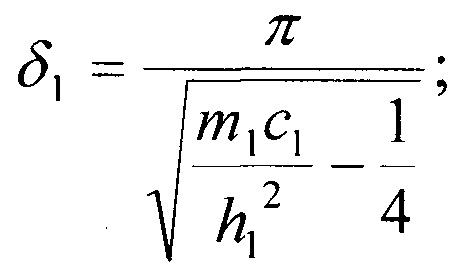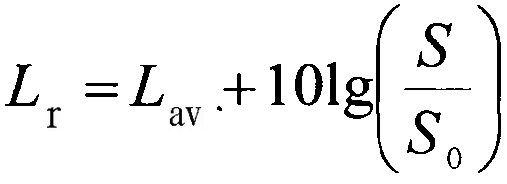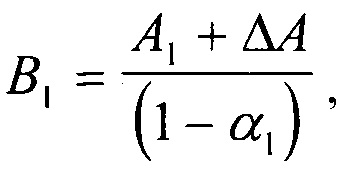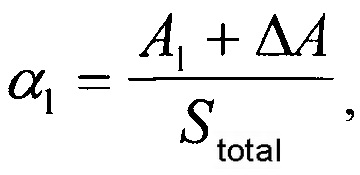FIELD: testing equipment.
SUBSTANCE: bench for vibroacoustic tests of samples and models contains the basis on which through at least three vibration-isolators the bulkhead is fixed, representing the single mass oscillating system with mass and stiffness accordingly,m2 and c2, and the eccentric mass vibrator is used as the harmonic oscillations generator, located on the bulkhead, differs in that the rack installed on the bulkhead for testing the natural frequencies of elastic spring elements and disc vibration isolators of different length, geometrical parameters, as well as different masses size, fixed at the ends of these tested elements. The oscillations of the mass, fixed on each elastic element, are fixed by the displacement indicator, according to the indications of which the resonance frequency corresponding to the parameters of each elastic element is determined. The vibration acceleration sensors are fixed on the base and bulkhead, the signals from which send to the amplifier, then to the oscillograph, the magnetograph and computer for processing of the received information. The frequency meter and phase meter are used to adjust the bench's performance, and to determine the natural frequencies of each of the vibration isolation systems being tested, the simulations of shock impulse loads are performed for each of the systems and oscillograms of free oscillations are recorded. When decoding this, the natural frequencies of the vibration isolation systems and the logarithmic decrement of oscillations damping are determined by the formula  , where c1 and m1 - respectively, the rigidity of the vibration isolators elastic elements and the base mass, c2 and m2 - respectively, the rigidity and mass of the bulkhead, h1 - the absolute value of viscous damping in the system, which is related to the logarithmic damping coefficient δ1 of oscillatory system. The sound power level Lp is determined from the measurements results of the average sound pressure level Lav at the measuring surface S, m2, for which the area of the hemisphere
, where c1 and m1 - respectively, the rigidity of the vibration isolators elastic elements and the base mass, c2 and m2 - respectively, the rigidity and mass of the bulkhead, h1 - the absolute value of viscous damping in the system, which is related to the logarithmic damping coefficient δ1 of oscillatory system. The sound power level Lp is determined from the measurements results of the average sound pressure level Lav at the measuring surface S, m2, for which the area of the hemisphere  is taken, where S=2πr2; r is the distance from the source center upto the measurement points; S0=1 m2, and the corrected sound power level LpA
is taken, where S=2πr2; r is the distance from the source center upto the measurement points; S0=1 m2, and the corrected sound power level LpA  , where LAav - the average sound level at the measuring surface. The sound pressure level ΔL reduction value in the reflected sound field of the sample is calculated by the formula
, where LAav - the average sound level at the measuring surface. The sound pressure level ΔL reduction value in the reflected sound field of the sample is calculated by the formula  , where L - the sound pressure level at the calculated point before the acoustic treatment of the room, dB; Lobl - the sound pressure level at the calculated point after acoustic treatment of the room, dB; B - vessel's cabin constant before its acoustic treatment, m2; B1 - room constant after its acoustic treatment, m2, which is defined by the formula
, where L - the sound pressure level at the calculated point before the acoustic treatment of the room, dB; Lobl - the sound pressure level at the calculated point after acoustic treatment of the room, dB; B - vessel's cabin constant before its acoustic treatment, m2; B1 - room constant after its acoustic treatment, m2, which is defined by the formula  where A1=α(Stotal-Sobl) - the equivalent area of sound absorption by surfaces not occupied by sound-absorbing lining; α=B/(B+Stotal) - the average coefficient of the sound absorption in the room before its acoustic treatment; α1 - the average sound absorption coefficient of acoustically treated room, defined by the ratio
where A1=α(Stotal-Sobl) - the equivalent area of sound absorption by surfaces not occupied by sound-absorbing lining; α=B/(B+Stotal) - the average coefficient of the sound absorption in the room before its acoustic treatment; α1 - the average sound absorption coefficient of acoustically treated room, defined by the ratio  where ΔA - the value of the total additional absorption, introduced by the design of sound-absorbing lining or single-piece sound absorbers, determined by formula ΔA =αoblSobl+ Apsn, where αobl - the reverberation coefficient of sound absorption of the lining design; Sobl - area of this design, m2; Aps - equivalent sound absorption area of one single-piece absorber, m2; n - the number of single-piece sound absorbers in the room. At each of the tested elastic elements of different lengths, the geometric parameters, and also the different masses, the strain gauges are attached to the ends of these tested elements. The mass oscillations, fixed at each elastic element, are registered both by the displacement indicator and by the strain gauges. The rapid assessment of the characteristics is carried out according to the indicator records, while processing the signals from the strain gauges coming to the amplifier, then to the oscillograph and magnetograph and computer for processing the received information, the amplitude-frequency characteristics are determined and the optimal characteristics are identified: stiffness and damping coefficient of each of the elastic elements.
where ΔA - the value of the total additional absorption, introduced by the design of sound-absorbing lining or single-piece sound absorbers, determined by formula ΔA =αoblSobl+ Apsn, where αobl - the reverberation coefficient of sound absorption of the lining design; Sobl - area of this design, m2; Aps - equivalent sound absorption area of one single-piece absorber, m2; n - the number of single-piece sound absorbers in the room. At each of the tested elastic elements of different lengths, the geometric parameters, and also the different masses, the strain gauges are attached to the ends of these tested elements. The mass oscillations, fixed at each elastic element, are registered both by the displacement indicator and by the strain gauges. The rapid assessment of the characteristics is carried out according to the indicator records, while processing the signals from the strain gauges coming to the amplifier, then to the oscillograph and magnetograph and computer for processing the received information, the amplitude-frequency characteristics are determined and the optimal characteristics are identified: stiffness and damping coefficient of each of the elastic elements.
EFFECT: expanded technological capabilities of objects testing, having several elastic couplings with the body parts.
2 cl, 7 dwg
Authors
Dates
2017-12-19—Published
2016-11-25—Filed